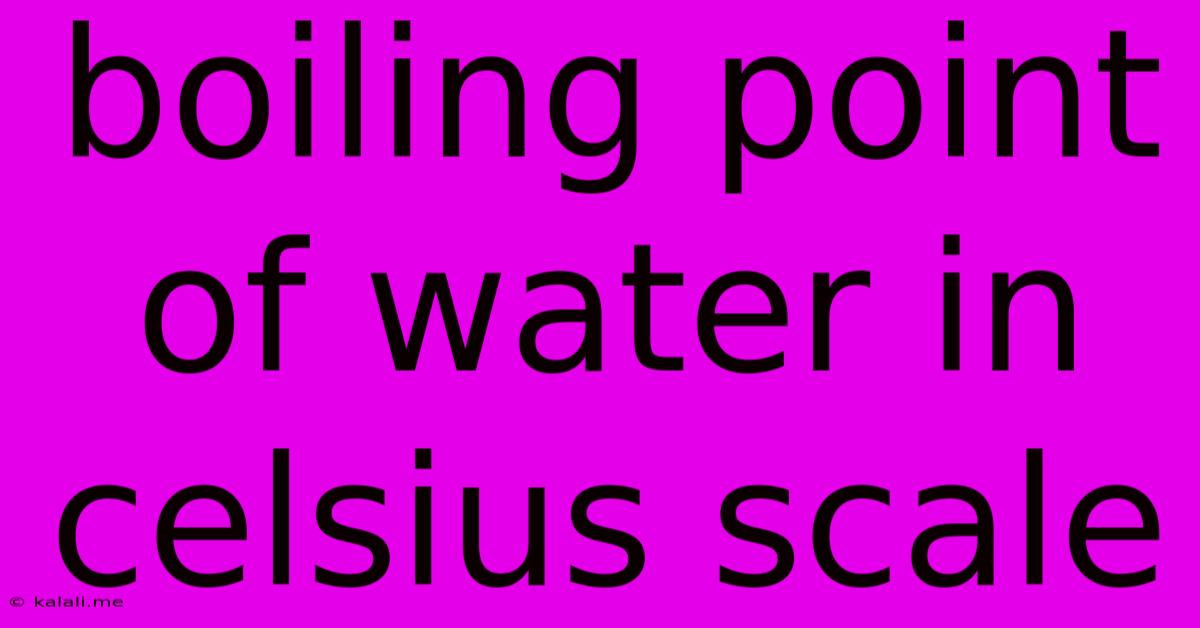Boiling Point Of Water In Celsius Scale
Kalali
May 09, 2025 · 3 min read

Table of Contents
The Boiling Point of Water: A Deep Dive into Celsius
The boiling point of water is a fundamental concept in science and everyday life. Knowing this temperature is crucial for countless applications, from cooking to industrial processes. This article will explore the boiling point of water specifically on the Celsius scale, delving into the factors that can influence it and debunking common misconceptions.
What is the boiling point of water in Celsius?
The boiling point of pure water at standard atmospheric pressure (1 atmosphere or 101.325 kPa) is 100 degrees Celsius (°C). This is a widely accepted and crucial benchmark in various scientific disciplines and everyday practices. It's the temperature at which liquid water transitions to its gaseous state, water vapor or steam.
Factors Affecting the Boiling Point
While 100°C is the standard, several factors can influence the actual boiling point of water:
-
Altitude: The higher the altitude, the lower the atmospheric pressure. Lower pressure means water boils at a lower temperature. At high altitudes like those found in mountainous regions, water boils at temperatures significantly below 100°C. This is why cooking times often need adjustments at higher elevations.
-
Impurities: Dissolved substances in water, such as salts or minerals, can elevate the boiling point. This phenomenon is known as boiling point elevation. The more impurities present, the higher the temperature required to reach the boiling point. This is why saltwater boils at a slightly higher temperature than pure water.
-
Pressure: As mentioned above, pressure is directly related to the boiling point. Increasing the pressure on the water increases its boiling point, while decreasing the pressure lowers it. Pressure cookers utilize this principle to cook food faster at higher temperatures.
Understanding the Phase Transition
The boiling point represents the phase transition from liquid to gas. At 100°C and standard pressure, the kinetic energy of water molecules overcomes the intermolecular forces holding them together in liquid form. This allows them to escape the liquid phase and transform into water vapor, forming bubbles within the water.
Debunking Common Myths
Many misconceptions surround the boiling point of water. Let's address some of them:
-
Boiling faster with higher heat: While higher heat will bring water to a boil quicker, it won't increase the boiling point itself. Once boiling starts, the temperature remains constant at 100°C (at standard pressure). Increasing the heat only increases the rate of vaporization, not the boiling temperature.
-
Boiling point is always 100°C: Remember that this is only true under standard atmospheric pressure. Variations in altitude and the presence of impurities will affect the boiling point.
Practical Applications
Understanding the boiling point of water is crucial in various fields:
- Cooking: Determining cooking times and methods.
- Chemistry: Performing experiments and chemical reactions requiring specific temperatures.
- Engineering: Designing systems involving water heating, cooling, and steam generation.
- Meteorology: Studying atmospheric conditions and weather patterns.
In conclusion, while the boiling point of water is typically stated as 100°C, it's essential to consider the influence of altitude, impurities, and pressure. Understanding these factors provides a complete picture of this fundamental scientific concept and its practical applications in our daily lives. This knowledge enhances our understanding of the world around us and improves our ability to perform various tasks efficiently and effectively.
Latest Posts
Latest Posts
-
Cuanto Equivale Un Pie En Centimetros
May 09, 2025
-
Has A Definite Volume And Shape
May 09, 2025
-
Is 38 A Prime Number Or A Composite Number
May 09, 2025
-
What Is The Lcm Of 5 And 12
May 09, 2025
-
What Is 4 Percent Of 16
May 09, 2025
Related Post
Thank you for visiting our website which covers about Boiling Point Of Water In Celsius Scale . We hope the information provided has been useful to you. Feel free to contact us if you have any questions or need further assistance. See you next time and don't miss to bookmark.